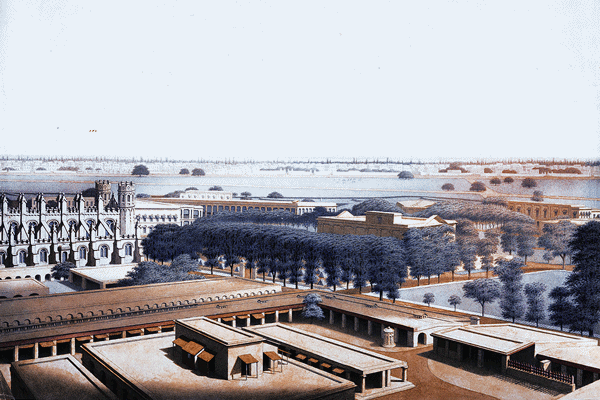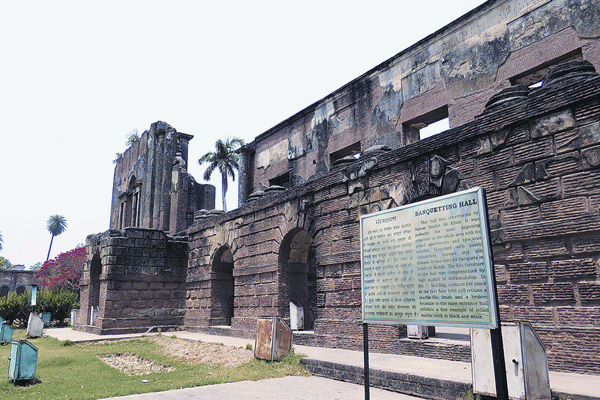The Freedom Trail
As India celebrates her 72nd Independence Day this August, Express TravelWorld peeps into the past to explore the historical freedom sites which offer the travel trade a niche product for history enthusiasts
EAST INDIA

Kolkata was the capital of British India before it was shifted to Delhi in 1911. Some great monuments built during that time and war memorials attracts local visitors even today. The places that attract majority of tourists are Victoria Memorial (1921), Tagore House (18th century), Howrah Bridge, Marble Palace (1835), Indian Museum (1814) and Shaheed Minar (1828).
Must Visit
- Victoria Memorial, Kolkata
- Shaheed Minar, Kolkata
- Fort William, Kolkata
- Hazarduari Palace Museum, Murshidabad
- Victory Pillar, Barrackpore
- Khonoma, Nagaland
This region played a crucial role in India’s struggle for Independence as it was a hotbed of resistance to foreign rule. The Battle of Plassey took place in the capital province of Bengal which included states like West Bengal, Odisha, Bihar, Assam, Bangladesh and Tripura. When the last free ruler of Bengal Siraj-ud-Daulah attacked Fort William in Kolkata, the British sent reinforcements headed by Colonel Robert Clive and Admiral Charles Watson to fight back. The end of the battle was the end of the ruler as he fled to Awadh while the Britishers took over the region. A small memorial on the banks of river Bhagirathi is a reminder of the Plassey battle.
Murshidabad
Murshidabad was another important region before the emergence of Kolkata. The Hazarduaari Palace built in the 1837 has been transformed into a museum. Also known as the palace with a thousand doors it was built for Nawab Najim Humaun Jah by British Duncan McLeod. There are various historical artifacts on display including armoury, paintings, portraits of the Nawabs, works of ivory (Murshidabad school) and of China, swords used by Siraj-ud-Daulah and his grandfather, Nawab Ali Vardi Khan. There is also the Khushbagh Cemetery where rest the remains of Siraj-ud-Daulah and Nawab Ali Vardi Khan.
Barrackpore
Barrackpore was the very first site of military barrack set up in 1772. The initial Revolt of the 1857 started here as the two rebellions took place led by Sepoy Binda Tiwary of the 47th Bengal Native Infantry. Now the place has been transformed into a garden in the memory of Mangal Pandey who led revolts against the British army. The Smarak Sanghralaya has many memoirs of Mahatma Gandhi’s work. The district was also home to Surendranath Banerjea, who together with Anand Mohan Bose organised the National Congress in 1883 which led to the birth of Indian National Congress. The Khadi Pratishthan in Sodepur was set up by an employee of Bengal Chemical, Satish Chandra Dasgupta. He was influenced by the work of Mahatma Gandhi and quit his day job to create cottage industry products.
The biggest stalwart from Bengal was Subhash Chandra Bose who was famously known as Netaji. He raised the Azad Hind Fauj or the Indian National Army and had a plan to gain India’ Independence. He was sent to the Alipore Jail and exiled to Burma. He was later released because of a hunger strike. His residence in Kolkata has been transformed into a museum consisting of archives and a library of Netaji Research Bureau.
The freedom trail in Kolkata leads you to the Victoria Memorial and the Shaheed Minar. The memorial surrounded by 64 acres of well manicured lawns was dedicated to Queen Victoria. The museum now houses memorabilia from India’s Independence movement. The Shahid Minar is a memorial for martyrs, built in 1828. The 218 steps of the tower lead you to the top which provides a bird’s eyeview of the city.
In Nagaland, Khonoma is a historic village located about 20 km from the state capital Kohima. It is recorded to have resisted British rule in the region from 1830s to 1880 and etched its name into the history of Indian resistance to the colonial invasion.
NORTH INDIA

With landmarks like the Red Fort in Delhi and Jallianwala Bagh in Amritsar marking historic movements in India’s freedom, the northern region of the country has many famous as well as little known sites that can be promoted as freedom trails.
Delhi
The many historic landmarks of Delhi have witnessed milestones in India’s freedom movement. The Red Fort in Delhi acquired a significant position when India’s first prime minister hoisted the national flag at the entrance and delivered his Independence Day speech. The lane leading from the Red Fort to Jama Masjid is a remembrance of the time the country celebrated its Independence. Delhi’s freedom trail also extends to Gandhi Smriti, a Gandhi memorial built in a home where he used to stay when he visited the city. In the museum you can find photographs, sculptures, frescos and other remains of his past.
Amritsar, Jallianwala Bagh Martyr’s Memorial
The bullet holes at the Jallianwala Bagh Martyr’s Memorial in Amritsar revive the horrific accident that shattered the country. Under the command of General Dyer, the British army fired over 1600 rounds of bullets at the large group of men, women and children gathered there for the Baisakhi festival. The memorial was inaugurated by India’s first president, Dr Rajendra Prasad.
Lucknow and Meerut
The beginnings of freedom struggle started in the erstwhile region of Awadh. Famously known as The Indian Rebellion of 1857, it refers to the rebellion that broke out against the rule of British East Indian company. Our history books define it as the Revolt of 1857 or First War of Indian Independence. A mutiny broke out between the sepoys of East India company’s army in Meerut and soon the revolt spread like wildfire to Uttar Pradesh, Madhya Pradesh and central India. It posed a significant threat to the company who could see their rule weaken in the army. Leaders like Mangal Pandey and Rani Lakshmi Bai are legendary for their brave fight against the British Raj. The Martyrs’ Memorial in Awadh commemorates the memory of the brave Indian soldiers who gave up their life fighting against their British masters. In Lucknow, the ruins of The Residency mark the struggle of Indians to fight British dominion. The complex houses a museum consisting of lithographs, photographs and paintings that are reminders of the fierce battle.
Must Visit
- Martyr’s Memorial, Meerut
- Lucknow Residency Museum, Lucknow
- Kanpur Memorial Church, Kanpur
- Christ Church, Kanpur
- Nana Rao Park, Kanpur
- Red Fort, New Delhi
- Jallianwala Bagh Memorial, Amritsar
About 80 km from Lucknow is Kanpur which became the headquarters of struggle led by Nana Sahib. The Nana Rao Park and Sati Chaura Ghat-Massacre Ghat, Kanpur Memorial Church and Christ Church are reminders of 1857.
SOUTH INDIA
There are not many landmarks related to the freedom movement in south of India. However, the Cellular Jail in Andaman & Nicobar Islands stands out as an exception.

Cellular Jail
The Cellular Jail in Port Blair completed in the year 1906 acquired the name ‘cellular’ because it was entirely made up of individual cells for solitary confinement. It came to be known as ‘Kala Paani’ that housed freedom fighters after the Revolt of 1857. The jail had seven wings, each having cells for solitary confinement of prisoners. To rebel against the hardships by the jail authorities, the prisoners went on a hunger strike. Three prisoners died during the strike after which the authorities stopped issuing drinking water. The freedom fighters did not budge and their demands had to be met after a gruesome 46 days.
The place has now been declared as a National Memorial and has become a place for pilgrimage for all freedom loving people. The memorial houses freedom fighters’ photographs and an exhibition gallery on the ground floor. The Netaji art gallery and a library on the freedom movement remind people of India’s rich history. Apart from the gallery on First War of Independence, a Freedom – Swatantrya Jyot has been erected in the vicinity of the Cellular Jail in memory of all freedom fighters and martyrs. A visit to the jail memorial is a thrilling reminder of the hard days of India’s freedom movement.
Mysore and Bengaluru
In the late 18th century, Mysore or Mahishuru, was under the power of Tipu Sultan who was known as the Tiger of Mysore. A series of wars were fought here. The third war saw the defeat of Tipu Sultan where he surrendered half of his kingdom to the British East India company. Tipu Sultan’s Summer Palace in Bengaluru is a must visit place. The palace is known for its teak pillars and ornamental frescoes. The 17th century Venkataraman Temple nearby and the massive Jamia Masjid make it a site worth a visit. Daria Daulat Bagh in Srirangapatna district of Mandiya houses a museum. There are exhibits like oil paintings, pencil sketches, aquatints and engravings, coins and medals, costumes, furniture, arms, etc, mostly related to Tipu Sultan.
Madurai
Madurai became an important landmark because it was visited by Mahatma Gandhi almost five times. On his second visit in 1921, he was deeply moved by the condition of poor farmers. In 1934, he refused to enter the Meenakshi Temple because his escort was not allowed. The latter was a Harijan who were not allowed to enter temples at that time. This initiated a movement across the country for entry of untouchables in the temples. The temple also has a mural of Mahatma Gandhi which was made during the renovations. The Gandhi Memorial Museum is located in Tamukkum Summer Palace of Nayaka queen Rani Mangammal and houses 14 original artifacts used by the Mahatma.
Must Visit
- Tipu Sultan’s Summer Palace, Bengaluru
- Cellular Jail, Andaman and Nicobar Islands
- Gandhi Memorial Museum, Madurai
WEST INDIA

The western region of India has been closely associated with the freedom struggle of the country, leaving behind a grandeur of heritage and history holding deep significance. In order to utilise this heritage as a tourism offering, some travel agencies and non – profit organisations conduct special tours. However, a large segment of this offering still remains untapped by the tourism industry.
Apart from reknowned personalities associated with the Indian freedom struggle, Maharashtra Ex-servicemen Corporation (MESCO) had initiated ‘Veer Yatra Military Tourism’, which not only sheds light on the history, but also imparts awareness about the defence forces through various tour packages in Maharashtra.
Mumbai
Located on the Laburnum Road in Gamdevi in Mumbai, Mani Bhavan served as an important place where Mahatma Gandhi carried out his activities for India’s Independence, while he was in Mumbai (then Bombay). Mani Bhavan belonged to Shri Revashankar Jagjeevan Jhaveri who was an ardent devotee of Gandhi and his host during that period. Mani Bhavan was the epicentre of India’s freedom struggle, especially between 1917 to 1934. The first phase of non-violent freedom struggle was launched here. This heritage building is now a tourist attraction, drawing a number of visitors from India and abroad. Mani Bhavan Gandhi Sangrahalaya is open througout the week between 9.30 am to 6.00 pm.
A walk around Mumbai gives a glimpse of the past. One can start from the Gateway of India, the Indo-Saracenic archway built to commemorate King George V’s visit to India. Another important event that adds to the historical significance of the place is that the last British platoon left from here, marking an end to the 282 years of British rule in the country. The Azad Maidan where people gather to play cricket today was where Gandhi addressed the largest gathering of people.
Must Visit
- Mani Bhavan, Mumbai
- Sabarmati Ashram, Ahmedabad
- Watson Museum, Rajkot
- Kaba Gandhi no Delo, Rajkot
- Kolaba Fort, Raigad, Maharashtra
- The Aga Khan Palace in Pune
The Aga Khan Palace in Pune, built by Imam Muhammad Shah Aga Khan III in 1892 is where many prominent freedom fighters were placed under arrest. Mahatma Gandhi, along with his wife Kasturba Gandhi, and Mahadev Desai stayed in the palace during the Quit India Movement in 1942. The palace has been transformed into a museum with some pictures of the freedom struggle.
Located at a distance of two km from the shores of Alibag, the Kolaba Fort is surrounded by sea and has two chief entrances. In 1662, Shivaji Maharaj toughened and fortified Kolaba fort and made the fort one of his main naval centres. The charge of the fortress was given to Darya Sagar and Manik Bhandari under whom Kolaba fortification became the heart of Maratha assaults on British ships.
Porbandar and Ahmedabad
On October 2, 1869, Mahatma Gandhi was born in a three-storey building in Porbandar. Now called Kirti Mandir, the building has been converted into a small museum, with an exhibit of old photographs, some of his possessions and a library of books.
Situated 34 km from Surat, Bardoli town saw the birth of the ‘No-tax movement’ led by Sardar Patel, in protest of the British rule. It was a precursor to the Namak Satyagraha. The Swaraj Ashram, garden, museum, and khadi workshops, are worth a visit, as well as the Aitihasik Ambo, a mango tree under which Gandhi declared that he would settle for nothing less than independent home – rule for India. For many years Ahmedabad was the centre of Mahatma Gandhi’s non-violent struggle. One can get a sense of his life, the history of the movement at the Gandhi Smarak Sangrahalaya, a small museum that includes pictorial and written documentation, a library of Gandhian literature and paintings, and an archive of letters written by him.
Goa
The Reis Magos Fort was initially used to house viceroys and other dignitaries who were arriving from or departing to Portugal. With the threat of invasion from neighbouring Indian states, the fort became a military stronghold. It is said that the British occupied the fort from 1798 for the duration of the Napoleonic wars. The fort is now a cultural centre and a prominent tourist attraction.

